FullSession vs. Hotjar Heatmaps: Which Wins for SaaS? ...

Top 5 Product Analytics Software in 2025
Diving headfirst into a data-driven culture isn't just a trend—it's a transformational shift that's defining the digital age. Today, businesses are swapping gut instincts for data-driven strategies, demanding a new arsenal of cutting-edge product analytics tools.
These tools don't just crunch numbers. They unlock secrets to product improvement and smarter decision-making.
Enter the world of specialized product analytics tools. These powerhouses monitor customer interactions across platforms, uncover patterns, and refine product strategies, all while driving up customer engagement, increasing conversions, and solidifying customer loyalty.
Are you scouting for the best product analytics tools? Perfect timing! In this article, we’re about to unpack the top five tools on the market, exploring their features and benefits to help you make a savvy choice swiftly.
Ready to get started? Let's dive into the essentials of product analytics tools and see how they can revolutionize your approach.

Image source: Freepik
What Are Product Analytics Tools?
Product analytics tools are your secret weapon in understanding how users interact with your products.
Imagine being able to see every click, scroll, and purchase, turning what might seem like mundane actions into a treasure trove of insights–this is what makes product analytics tools important.
These tools help you get into the minds of your users and uncover what draws them in, what turns them away, and how they navigate through your offerings. By analyzing user data, you can pinpoint areas for improvement and create offerings that drive satisfaction and loyalty.
What Data Do Product Analytics Tools Collect?
What kind of data do product analytics tools collect, and why is it so valuable? Let's dive into the rich pool of insights these tools provide, whether for your website, online shop, or app.
User Demographics
Think your product is one-size-fits-all? Think again. Digging into demographics like age and gender can reveal surprising insights into how different groups use your product - and how you can tailor your approach to win them over.
By understanding the needs and preferences of specific groups, you can craft marketing strategies and product features that truly resonate with them, elevating their overall experience.
Product Usage Patterns
Imagine being able to peer over your user's shoulders as they navigate your site or app.
What do your users really care about? A peek at product usage patterns will tell you, detailing exactly which features capture their attention and how long they're willing to linger. Reliable data is the game-changer you need to engineer features that genuinely impress.
User Engagement
This metric shows how well your product sticks with users. Users who are fully invested in your product send a clear message: you're doing something right. On the flip side, lukewarm engagement can be a red flag, signaling areas that need a refresh.
In other words, user engagement metrics help you understand what keeps users coming back or what might be turning them away.
Session Analytics
Ever wonder what happens during a user’s visit? Session analytics break down user actions within a session, providing a storyboard of how users move through your site or app.
Friction and frustrations are exposed, and transitions are smoothed, resulting in a significantly improved user flow that directly correlates to increased user happiness.

Image source: Pixbay
How Do Companies Use Product Analytics Tools?
By tapping into product analytics, you can unlock valuable insights that inform your strategy. It's about more than just tracking sales or identifying leads. It's about using data to optimize every aspect of your business.
Imagine having the competitive edge you need to surge ahead in your industry. It starts with using these tools to maximum effect – and that's exactly what the most successful businesses do.
Measuring Product Performance
What if you had a dashboard that not only tracks every sale but slices and dices the data to show you who your buyers are, where they come from, and what exactly they're buying?
Product analytics tools allow you to monitor these metrics in real time and let you see which products are flying off the shelves and which might need a marketing boost.
Identifying Potential Customers
With product analytics, you're not just seeing who's buying. You're discovering who could be buying. Identify customer lukewarmth with tools that pinpoint interested users who are still on the fence about making a purchase.
Armed with this information, you can craft targeted offers or campaigns that convert these on-the-fencers into loyal customers.
Measuring Marketing Effectiveness
What’s the ROI of your latest marketing campaign? Product analytics tools take the guesswork out of this equation.
Your users are telling you something – are you listening? By analyzing their behavior and engagement, you'll pinpoint what's working and what needs a tune-up. In turn, you can make sure that every dollar you spend is an investment towards greater returns.
Tracking Internal Performance
Beyond external metrics, product analytics can turn the microscope inward to analyze your product's internal health.
From feature usage to load times, these insights help you understand the user journey on a granular level, allowing you to make precise improvements that improve the overall user experience.
Finding Problems
Before small issues become big headaches, product analytics tools flag anomalies and trends that could indicate problems. Whether it’s a sudden drop in user engagement or a glitch in the checkout process, you’ll have the data you need to intervene swiftly and effectively.
Look at all the ways product analytics tools can be applied, and it's no surprise they offer so many benefits. The most critical ones are up next.
Benefits of Product Analytics Tools
Here are six compelling benefits that underscore why integrating such a tool into your operations can lead to transformative outcomes:
- Deep dive into customer insights: Product analytics tools peel back the layers of your customer interactions and provide a crystal-clear view of user needs and behaviors. With this data, you can make informed decisions about which features to roll out next or what updates to prioritize.
- Measure impact and identify opportunities: Once you've implemented changes, how do you know they're working? Take a closer look at your customer's path, and you'll start to notice recurring patterns – the points where they stumble, where they smile, and where they bail. Once you understand these chokepoints, you can revamp, renovate, and reboot to reignite customer love.
- Proactive problem solving: Spotting problems before they escalate can save you not only resources but also your reputation. Product analytics tools help you identify gaps or glitches in your product early on.
- Better cross-departmental communication: Keeping everyone on the same page isn't always easy, especially in larger organizations. Real-time data provided by product analytics tools ensures that all departments—from product and marketing teams—have a unified understanding of what’s working and what needs improvement.
- Reduce churn rates: Satisfied customers are loyal customers. To fix high turnover rates and exorbitant customer acquisition costs, take a tip from the usability experts: know thy users. Listening to their needs and straightening out kinks in their experience dramatically curbs fledgling buyer retention–and that bloated budget for replacement customers.
Features to Look For in Product Analytics Platforms
When you're on the hunt for a top-notch product analytics tool, there are a few key features you definitely want to keep an eye out for:
- User segmentation: This lets you break down data by specific groups, like age, location, or behavior. It's super handy for tailoring your strategies to different audiences and seeing who loves your product the most (or least!).
- Event tracking and interactive event analysis: You’ll want a tool that can track specific actions users take, like signing up, clicking a button, or making a purchase.
- Funnel analysis: Check if the tool can analyze how users move through a set process, like making a purchase or signing up.
- Real-time data: In the fast-moving world of tech, old news is no news. A tool that updates data in real-time helps you make quick decisions and stay ahead of the curve.
- Heatmaps and session replays: Seeing exactly where users click, scroll, and spend their time on your page can be a goldmine.
- Integration capabilities: Your product analytics tool should integrate seamlessly with other software you’re using. Seamless integration means less hassle and more powerful insights when data from different sources interact.
- Customizable dashboards: Because one-size-fits-all rarely fits anyone! Being able to tweak your dashboard to show the metrics you care about most makes your life a lot easier.

Image source: Freepik
5 Best Product Analytics Platforms of 2024
Picture this: you have a product that users love, and you're able to make data-driven decisions that propel growth. It all starts with picking the perfect analytics tool that translates user behavior into actionable insights.
Below, we've rounded up five stellar product analytics tools that are worth your attention.
1. FullSession
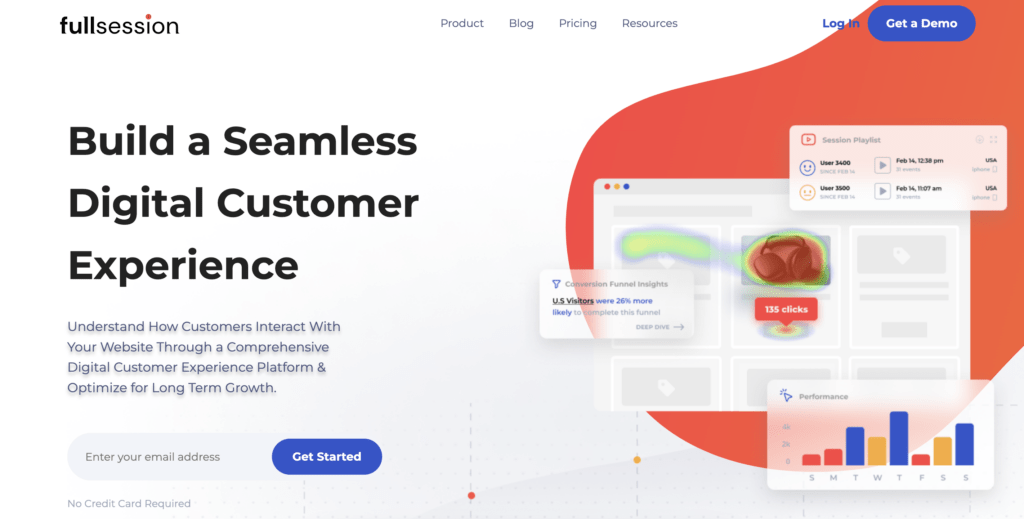
FullSession is more than just a behavior analytics tool—it's your gateway to really understanding what makes your users tick. With FullSession, you can dive deep into customer sessions and capture every click, scroll, and interaction.
Forget about simply gathering data; what you really need are specific, actionable clues that reveal exactly where users are hitting roadblocks or feeling the thrill of success.
By applying these insights, you'll craft a product that genuinely resonates with users, fostering a deeper connection and fueling a loyal following. And the best part?
FullSession does all this heavy lifting in the background and makes sure that your website’s performance remains smooth and speedy.
Session Replay
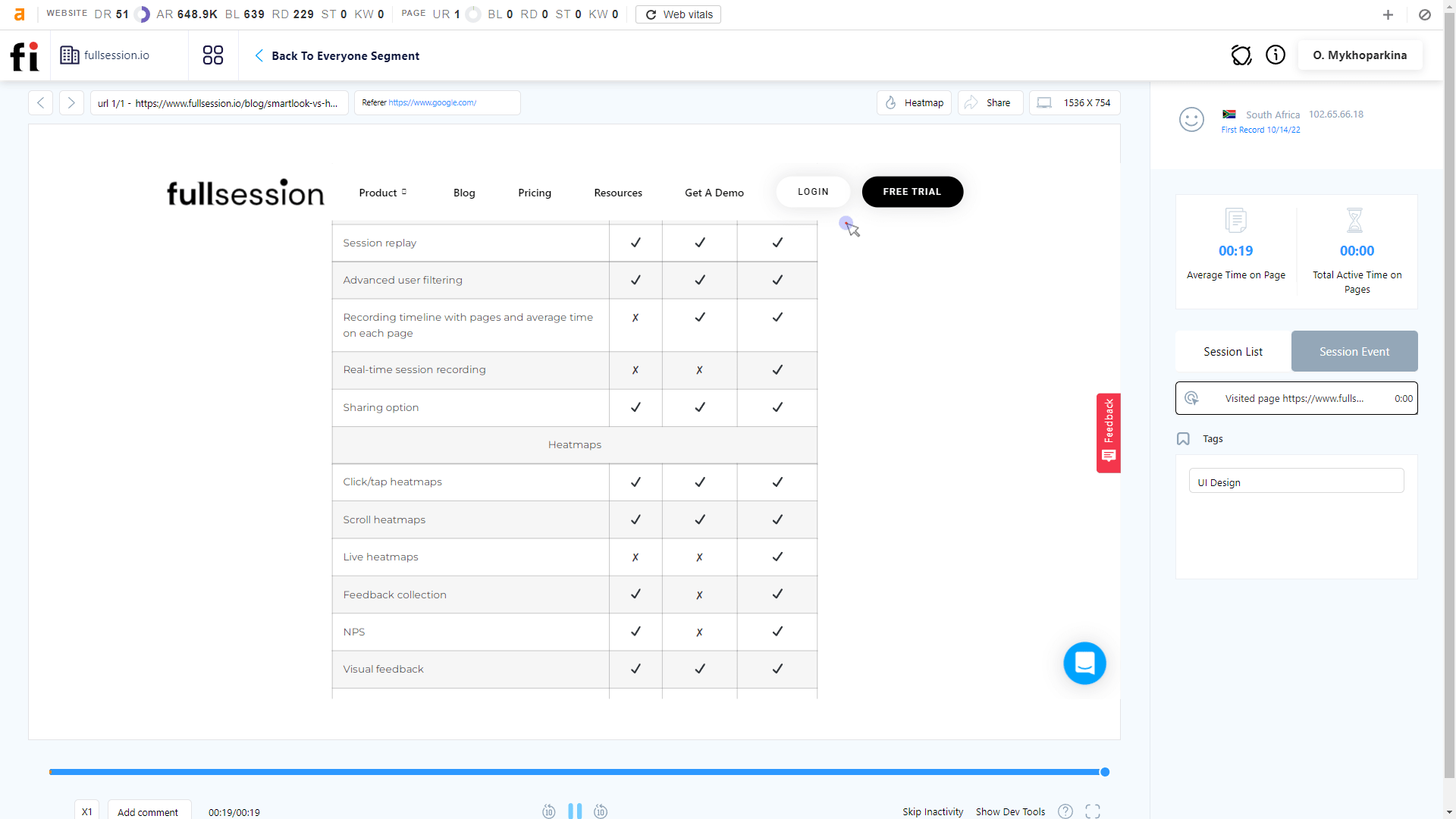
FullSession equips you with powerful session recording tools that let you observe how users engage with your website. Pull back the curtain on customer motivations: what captivates, what repels? Isolate the difficulties impeding your product's progress, and devise a corrective course to reinvigorate its development.
Total clarity means saying goodbye to endless tweaks and hello to a webpage that truly represents you. Trim the fat, power up your message, and watch your audience respond.
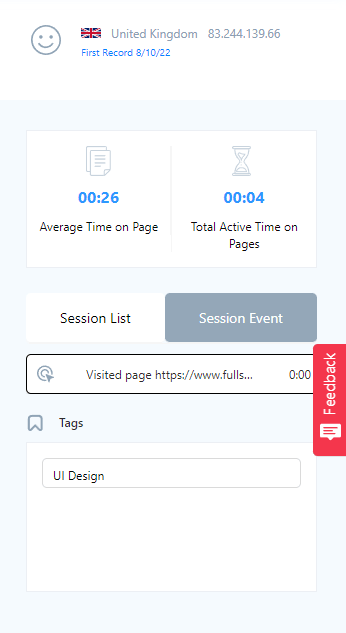
Pro tip: You can monitor user activity in days, weeks, months, or even years. You can watch entire sessions, skip periods of inactivity, pause, fast forward, and rewind each session recording.
FullSession Session Recording and Replay Data
- User locations and IP addresses
- Visited URLs
- Visit sources
- Session list
- The session event data
- Screen resolutions
- Average time on page
- Total active time on pages
Interactive Heatmaps
If you're keen on getting a deeper understanding of how users interact with your site, FullSession's interactive heatmaps are just what you need. With tools that track cursor movements, clicks, and scrolling behavior, you can literally see the hotspots where users are most engaged and the cold spots where they're not.
What's crucial here is recognizing the exact spots where users struggle or get bored and making adjustments to get them back on track. Product interactions can make or break the user experience.
By digging into these interactions, you'll uncover tangible ways to upgrade your product's functionality and charm, essentially marrying form and function in a way that users will love.
Ready to see these tools in action? Explore these examples of FullSession's interactive heatmaps in action, and see how they can help take your site to the next level.
Click maps
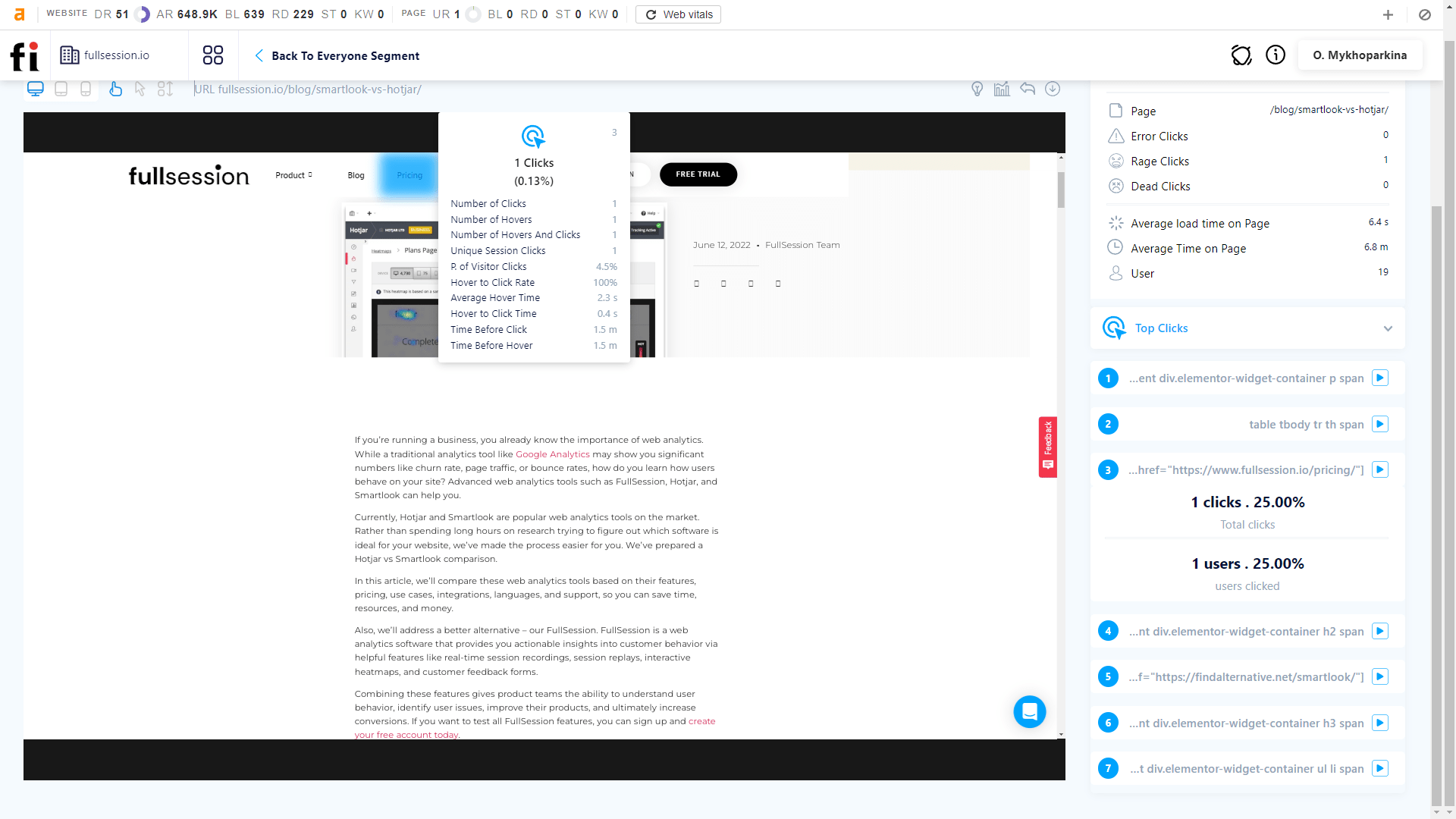
As the name suggests, click maps let you see what elements people click on the most on your web pages. Click tracking allows you to see what draws their attention.
Mouse movement maps
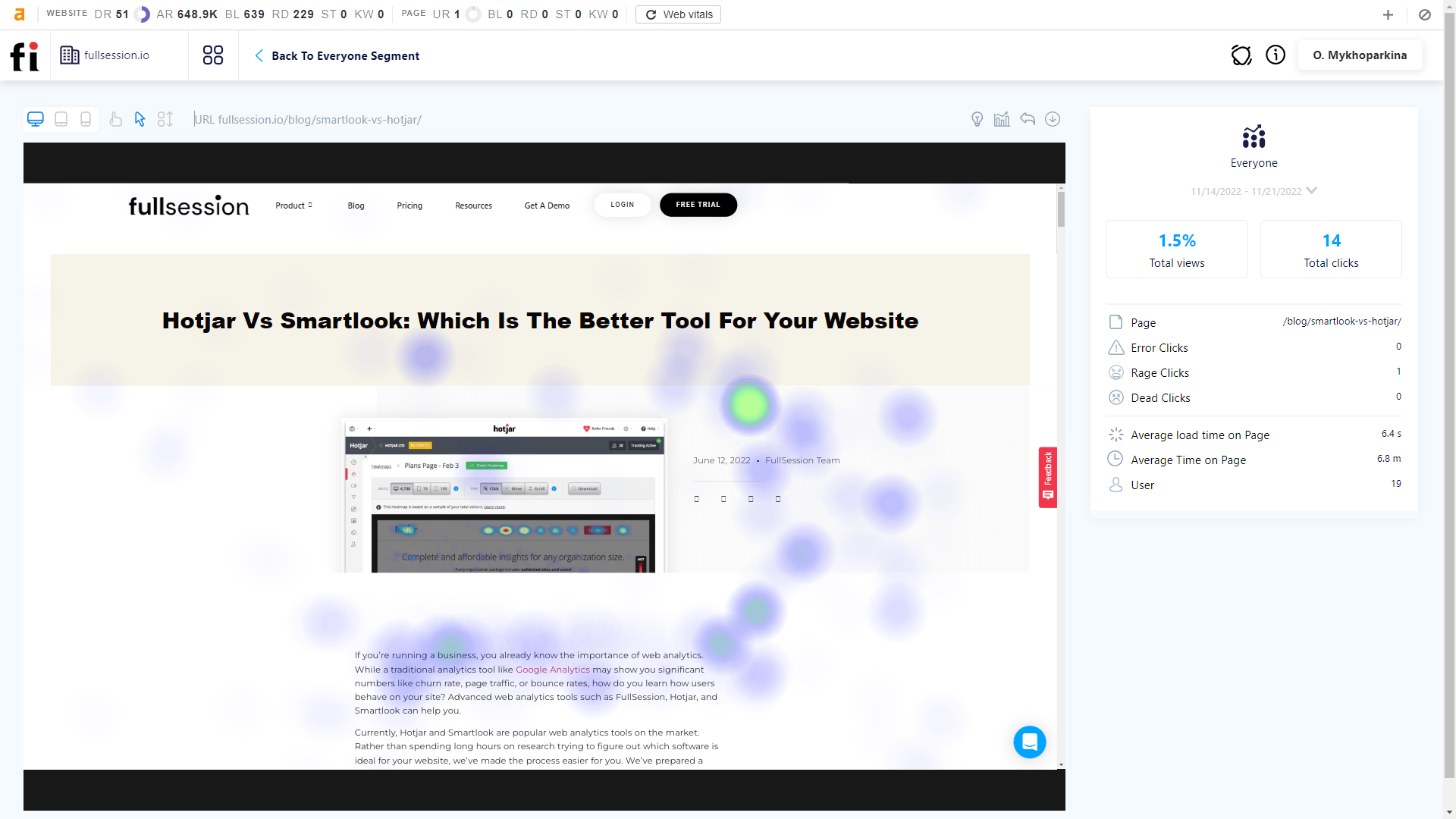
By mapping out cursor movements, you can see where users spend the most time and identify areas that may be causing confusion or frustration. An easy-to-navigate and understand website builds loyalty and trust, and this information is the first step in making that happen.
If you notice that users spend much time figuring out how to use a particular feature, you can make changes to make it more intuitive. Or, if you see users getting frustrated with a specific process, you can streamline it to make it more efficient.
Scroll maps
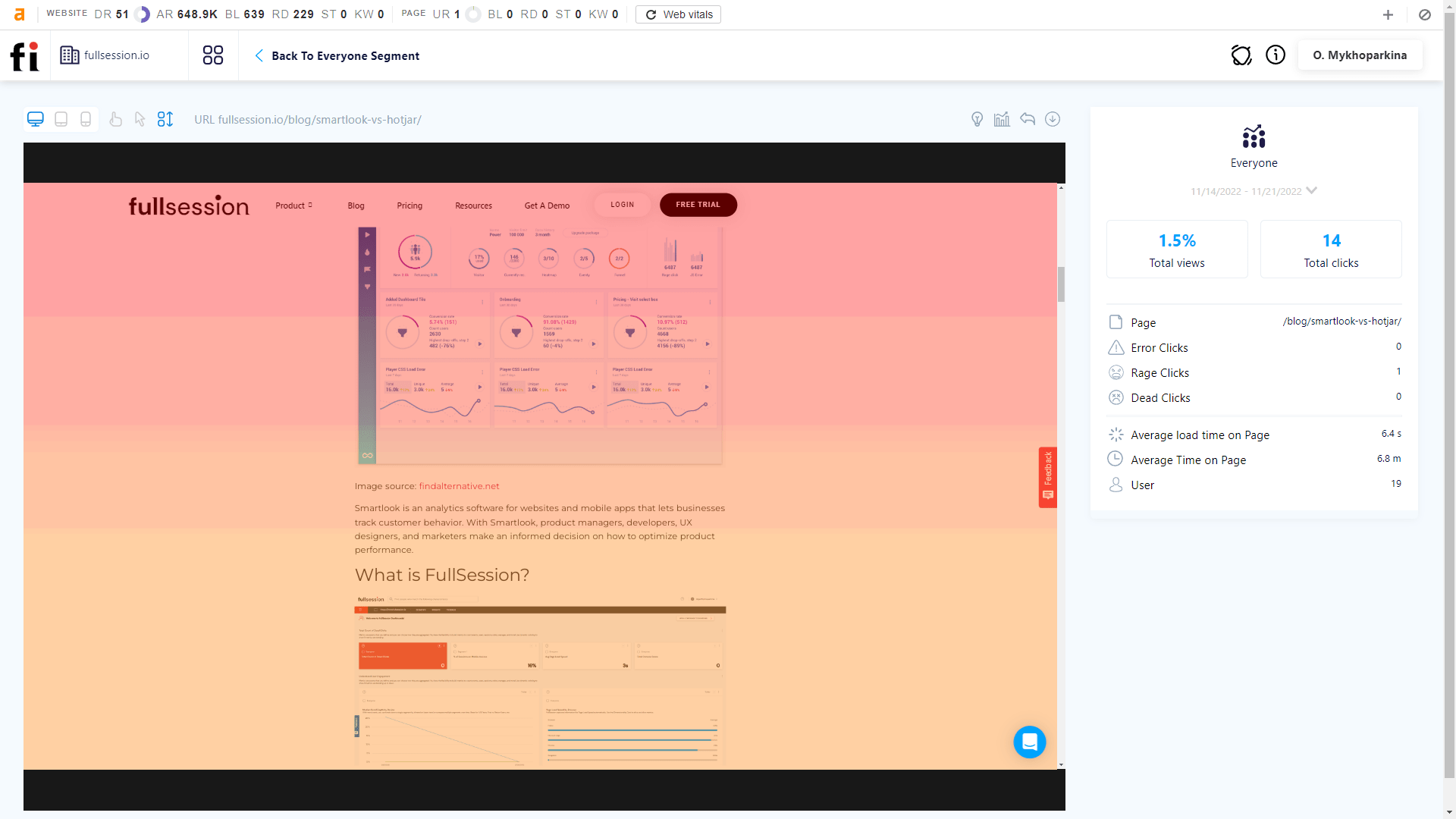
A scroll map represents how far users scroll down a page. It allows you to see which areas of the page are most popular and where users are most likely to scroll to.
You can use this information to place essential messages (such as a Call to Action) in the perfect spot. Scroll maps are handy for long pages, such as articles or product listings.
Customer Feedback Tools
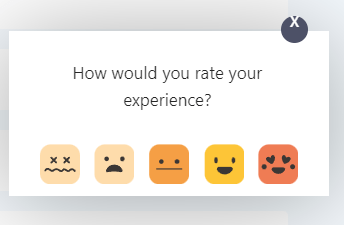
Customer feedback tools are your secret weapon in the quest to truly understand what your customers think and feel about your product—no need to shell out for pricey specialized NPS software.
What if you could finally get straight answers from your customers? A simple feedback form can be your ticket to a deeper understanding of what makes them tick. But why stop at forms?
Pair these insights with session recordings to watch your users in action. This dynamic duo of feedback and visual playback lets you dive deep into the customer experience, seeing firsthand where they thrive and where they struggle.

You can see all customer feedback on our dashboard, which makes tracking trends over time easy. The page offers various details, such as:
- Author’s identity
- Form’s name
- Creation date
- The number of responses
- Activity status
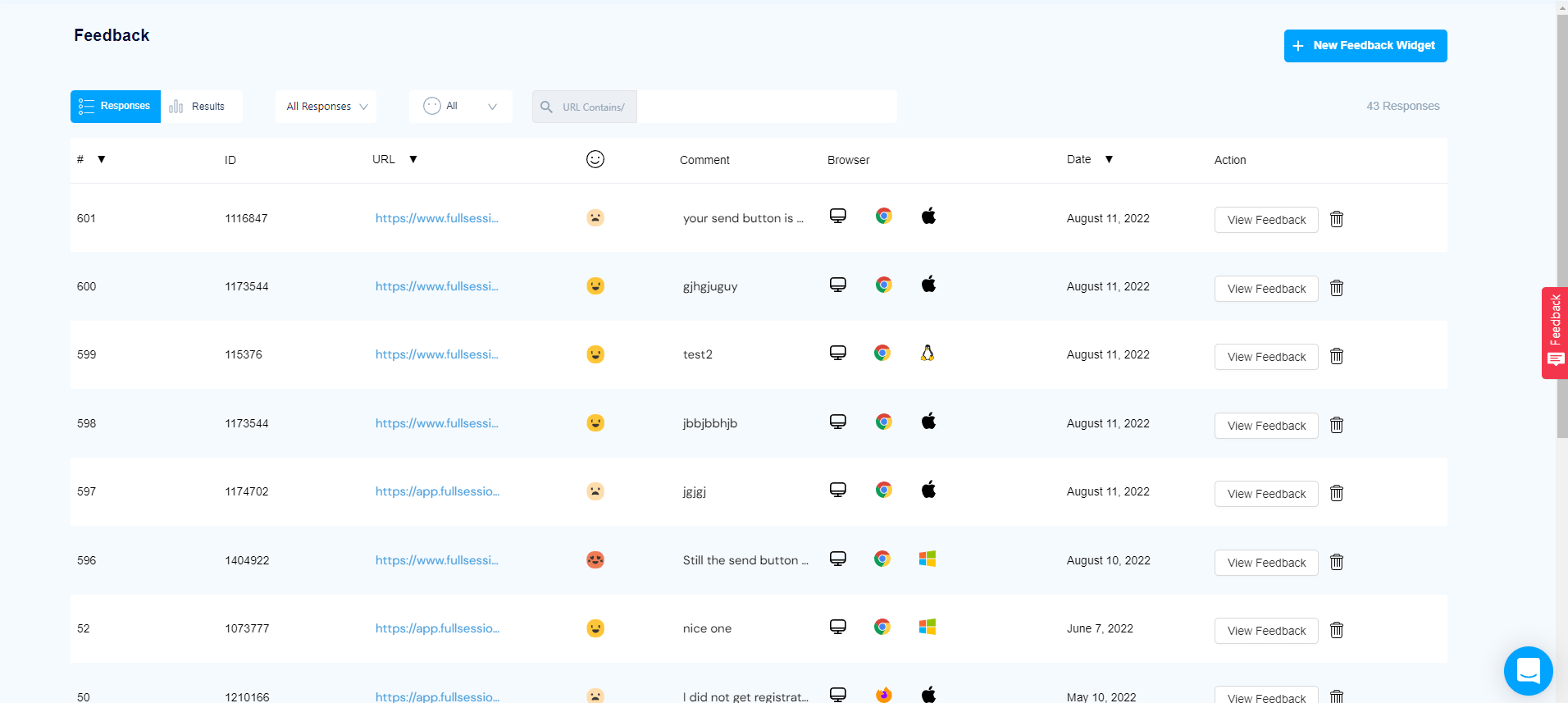
When monitoring your customer feedback forms, you’ll access even more details:
- Form’s ID
- URL
- Date
- User comments and individual feedback
- User sentiment (rating)
- Browser used
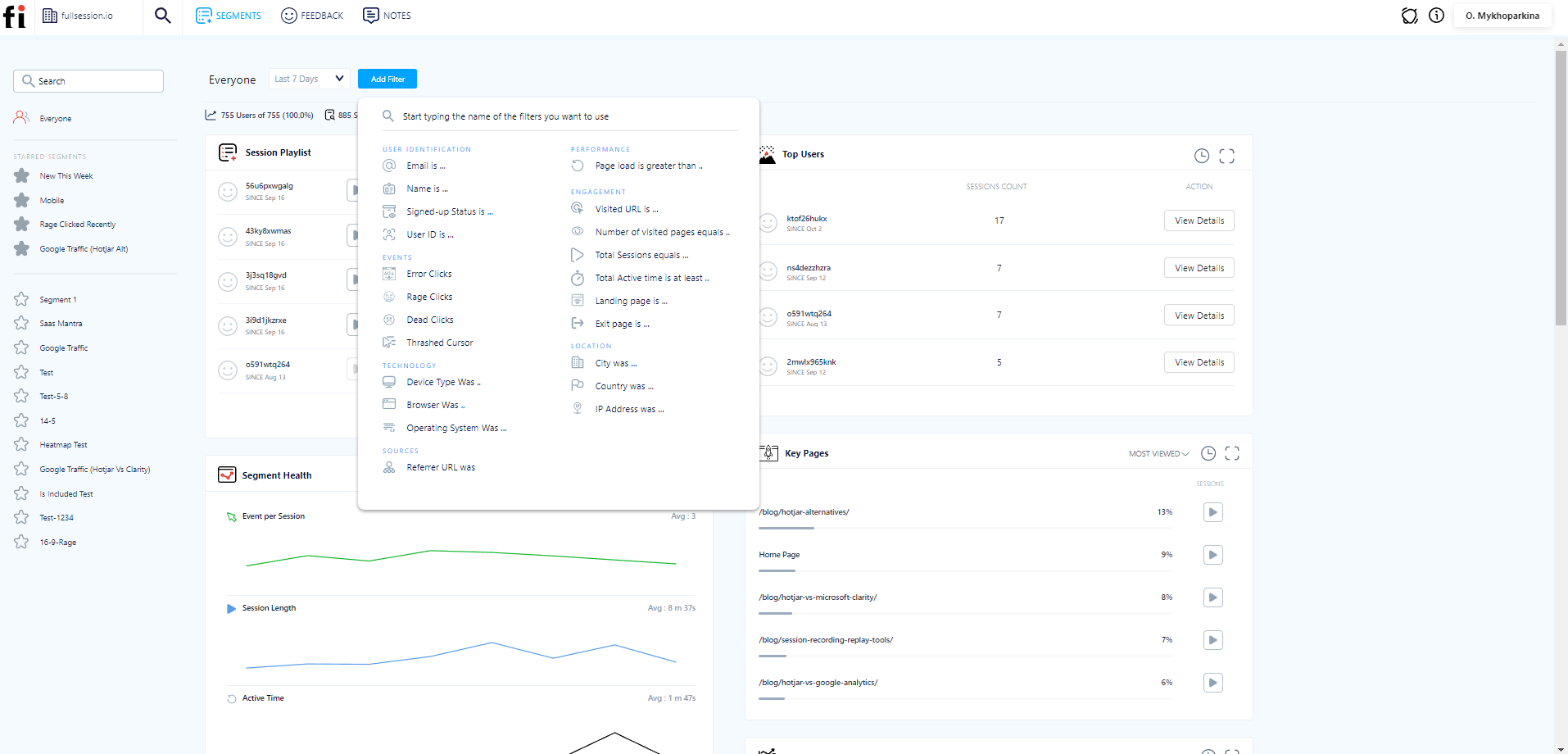
FullSession offers powerful segmentation and filtering features. You can find what you want to see during specific sessions with ease.
FullSession also offers a metrics page you can use to see website details, including
- % of sessions on mobile devices
- The number of dead clicks and error clicks
- Average page load speeds
- Median scroll depth
- Console errors
FullSession also helps with in-team and cross-team cooperation. You can leave notes to share information with other people.
You can use our platform to track conversion rates and other conversion-related data: % of converted users, time to convert, and more.
2. Auryc
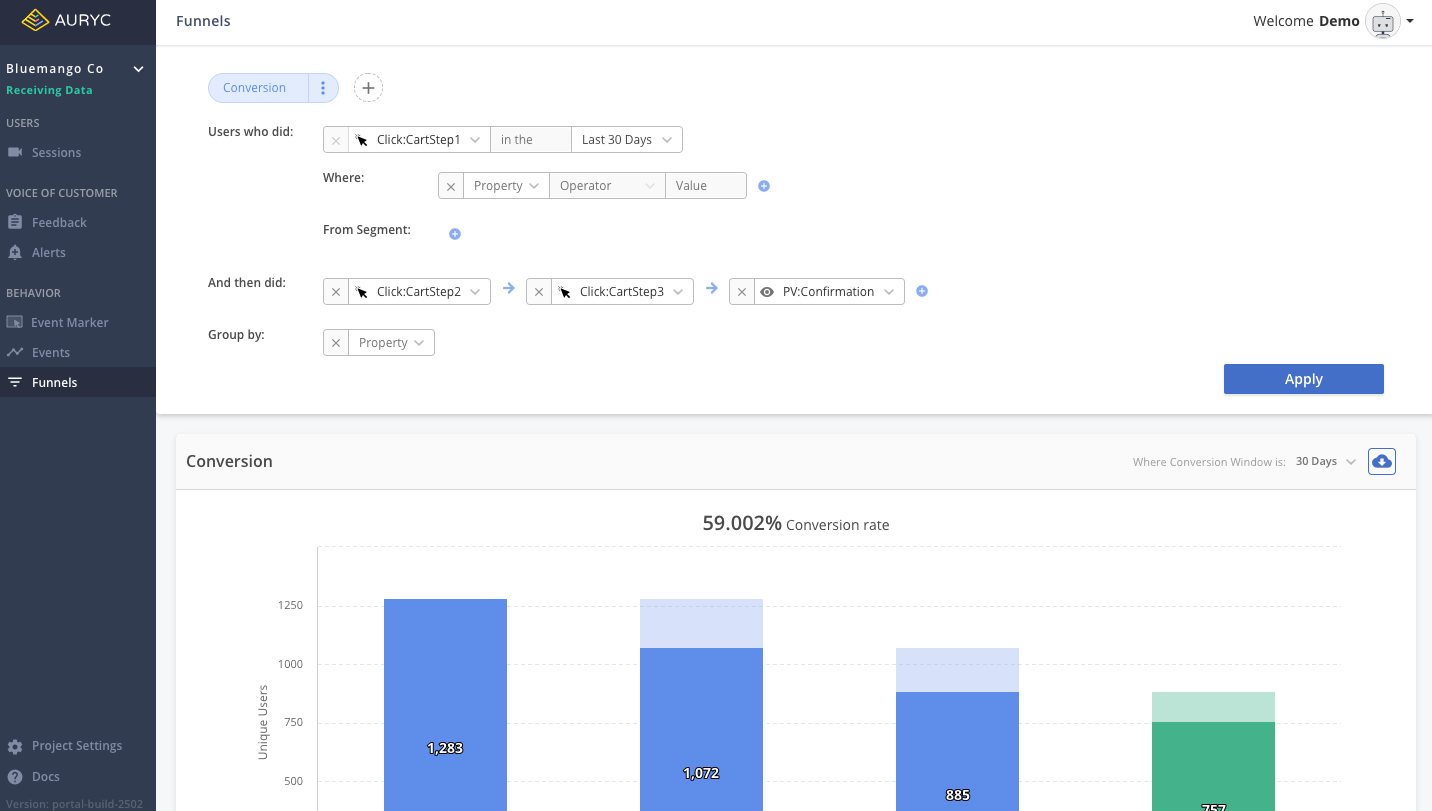
Image source: G2
From the moment users land on your site or launch your app, Auryc is there, capturing every click, swipe, and tap to help you build a richer, more intuitive experience. This powerful tool shows you exactly how users interact with your site.
With features like visual session replays, journey mapping, and super-clear heatmaps, you get the whole story of user experience.
What's really great about Auryc is how it handles feedback. You can pop surveys and feedback forms right into the user flow, catching folks exactly when they're most engaged. On the spot, you'll receive informed feedback that enables data-driven refinements.
Who Uses It?
Various specialists can use Auryc: customer support teams, UX designers, marketers, product teams, finance, operations, and IT departments.
Features
- Session replay: Watch user sessions to see how users navigate your site.
- Voice of customer: Gather valuable feedback directly from customers using integrated feedback tools.
- Event marker: Analyze data on specific events retroactively to understand user actions better.
- Heatmaps: Track where users click, move, and scroll to see what captures their attention.
- Insights: Access advanced analytics and dynamic reporting for deeper understanding.
- Mobile app analytics: Utilize Auryc's capabilities on mobile applications for consistent analysis across platforms.
- Smart funnels: Analyze and optimize your funnel to improve conversion rates.
- Smart path analysis: Track and understand user flows to enhance navigation paths.
- Reports: Create detailed e-commerce and B2B reports to inform business decisions.
Pros
- Provides various kinds of data
- You can use it on mobile devices
Cons
- Videos can be memory-intensive
- Some users complain about the maturity of some of the features
3. Indicative
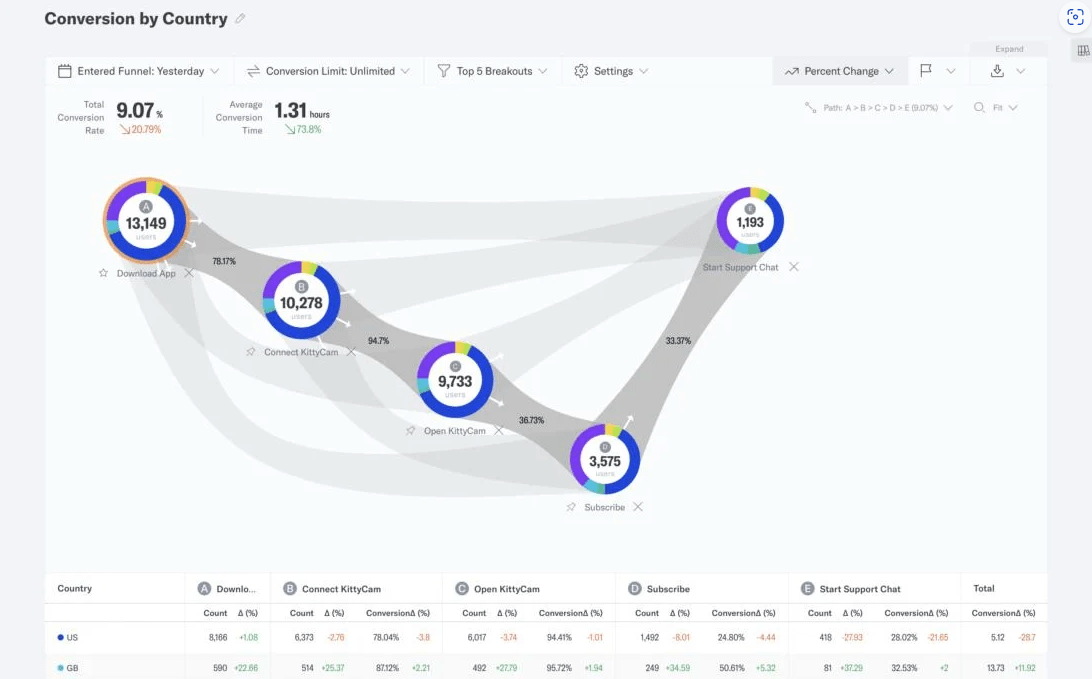
Image source: G2
With Indicative, the mystery of customer behavior dissolves, and you're left with actionable ideas that show you care about the people behind the numbers.
This platform makes customer behavior analysis accessible to anyone, regardless of technical expertise - no SQL knowledge required.
Who Uses It?
Indicative is a tool for product managers, marketers, and data analysts.
Features
- Customer journey analysis: Delve into the paths your customers take, uncovering insights that can lead to more effective marketing and product decisions.
- Cohort analysis: Segment users based on behaviors and track how these groups evolve over time.
- Behavioral targeting: Personalize experiences based on user actions to increase engagement and conversion rates.
- Multi-path analysis: View and analyze the many different paths users might take within your app or site, helping to identify the most critical areas for improvement.
- Integration simplicity: Easily connect with existing data sources for seamless data synchronization and analysis.
- User segmentation: Create dynamic user segments based on real-time behavior to target with more personalized campaigns.
- Event tracking: Capture and analyze specific user actions to see what drives user engagement and retention.
Pros
- Users don't need to know SQL to operate Indicative
- Offers in-depth insights into the paths customers take
- Features an intuitive dashboard that simplifies complex data analysis
Cons
- Some users may find the customization options for reports and dashboards limited compared to other more flexible platforms
- While providing significant value, the pricing can be a barrier for smaller companies or startups
- The sheer volume of data available can be overwhelming for users who are not used to working with complex analytics tools
4. Pendo
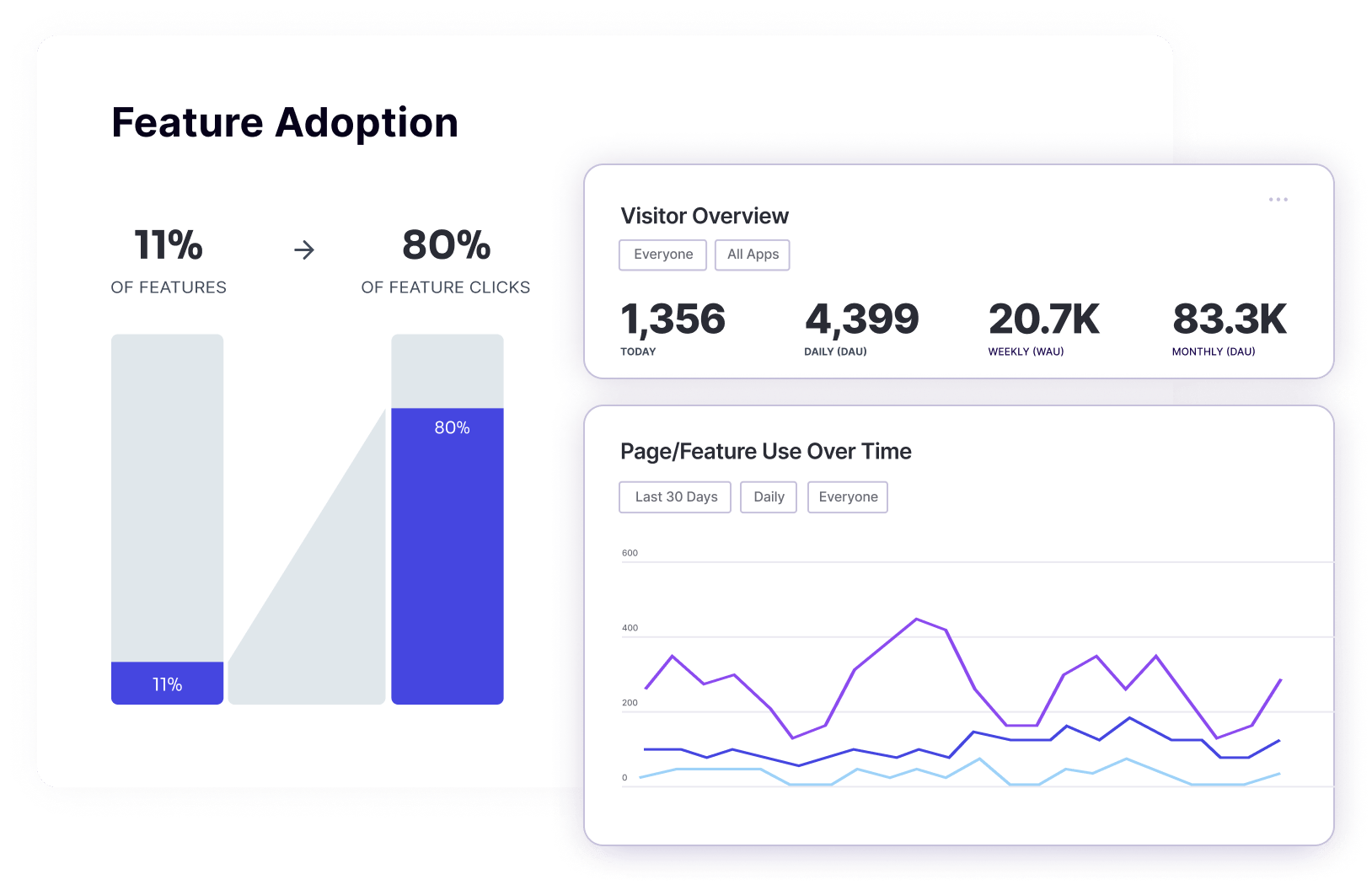
Image source: G2
What if you could pinpoint exactly what makes your users happy (or frustrated)? Pendo's digital experience intelligence tool is designed to listen in on their thoughts, behaviors, and habits, so you can refine your product to their exact needs.
There are, in fact, two tools–Pendo Engage and Pendo Adopt–but they form one comprehensive solution.
Who Uses It?
Pendo can be used by many specialists, such as marketers, product managers, UX researchers, web designers, and others.
Features
- Analytics: Gain insights into feature adoption and user behavior to better understand engagement and improve user interaction.
- In-app guides: Assist users directly within your application to enhance their experience and your communication.
- Roadmapping: Strategically plan and visualize product development paths to align with business goals.
- Mobile support: Extend functionality to mobile websites and apps, ensuring a consistent user experience across all platforms.
- Voice of the Customer: Gather and analyze customer feedback to refine products and services in alignment with user needs.
Pros
- Roadmaps help guide the product in the right direction
- Supports mobile devices
Cons
- Some users complain about limited data visualization
- Some reviews mention bad web performance, which impacts user experience
- Expensive for what it does
- It could be more intuitive
5. GainInsight
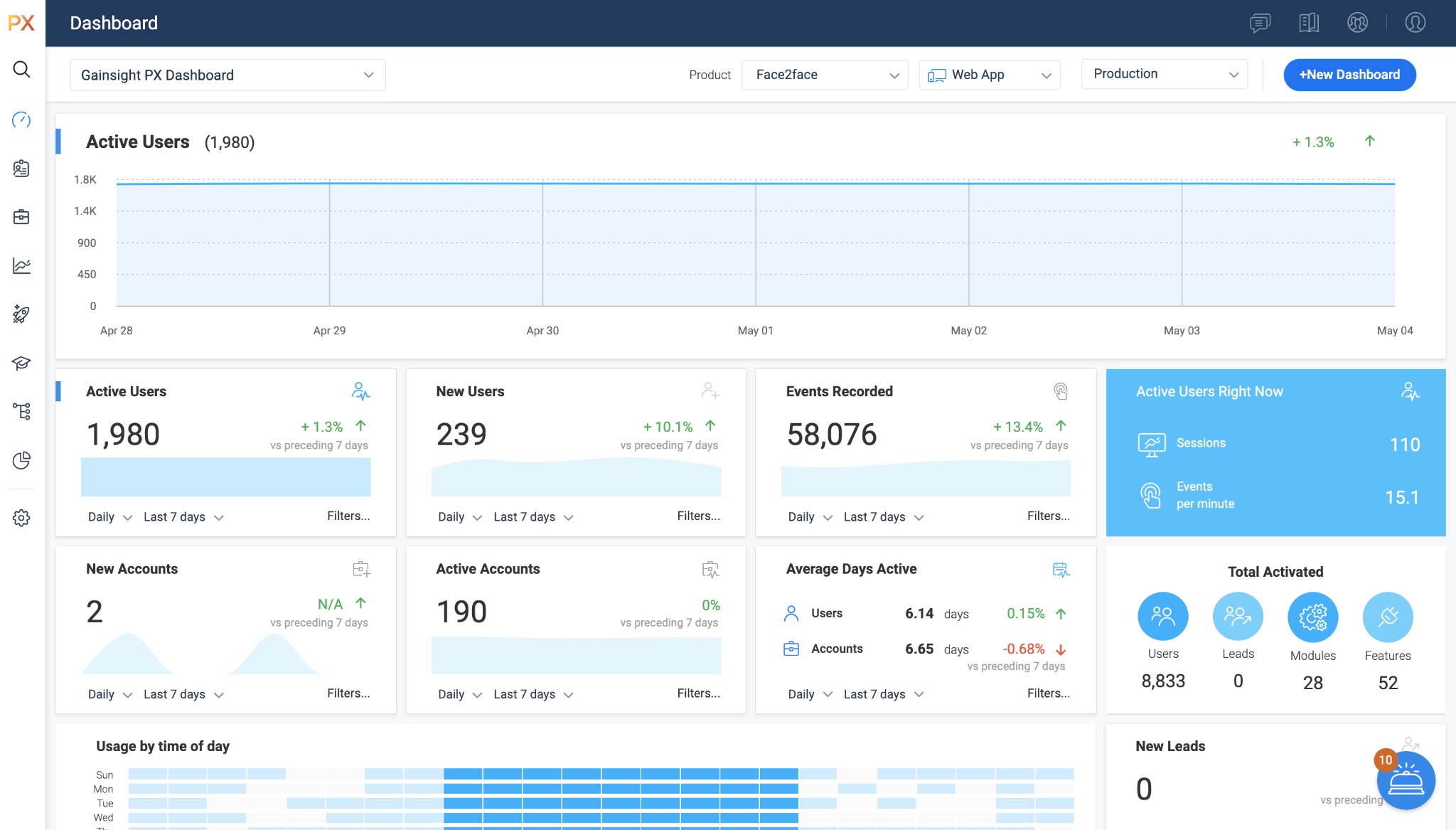
Image source: TrustRadius
Ever wonder what your users are really doing when they use your product? GainInsight is here to fill in the blanks, giving you a clear picture of their interactions.
Think of the platform as a three-legged stool, and each leg plays a vital role. Success hinges on three things: championing customer causes, spinning inspiring experiences, and harboring authentic, nose-to-the-grindstone familiarity.
Who Uses It?
GainInsight is for product teams, customer experience specialists, sales operatives, IT departments, community teams, and executives.
Features
- Advanced product analytics: Discover growth opportunities and delve into user paths and funnels to optimize user journeys.
- Native omnichannel engagement: Set up and customize in-app engagements, including onboarding checklists, to enhance user interaction across platforms.
- Closed-loop feedback: Deploy in-app surveys to collect extensive feedback, allowing for scalable and direct user insights.
- Product communication: Maintain an open line of communication with users, keeping them updated and engaged with your product developments.
- Horizon analytics: Monitor and analyze long-term trends with comprehensive data visualizations on dashboards.
- Success planning: Utilize GainInsight to refine and improve your product's effectiveness and market fit.
Pros
- You can use it with SaaS services, desktop, and mobile devices
- Comprehensive and robust tool that lets you collect various kinds of data
Cons
- May have a complex setup process
- The depth of product analytics data can be overwhelming, especially for users who are not data-savvy
- Maintaining and making the most out of GainInsight can require substantial ongoing time and effort from your team
Table Comparison
Here’s a short comparison of all five tools mentioned in this article.
|
Features |
FullSession |
Auryc |
Indicative |
Pendo |
GainInsight |
|
Real-time Session recording |
✔ |
✔ |
✘ |
✘ |
✘ |
|
Funnel analysis |
✘ |
✔ |
✔ |
✔ |
✔ |
|
Conversion tracking |
✔ |
✔ |
✔ |
✔ |
✔ |
|
Behavioral analytics |
✔ |
✔ |
✘ |
✔ |
✘ |
|
Customer segmentation |
✔ |
✔ |
✔ |
✔ |
✔ |
|
A/B testing |
✘ |
✘ |
✘ |
✘ |
✘ |
|
Customer journey mapping |
✘ |
✔ |
✔ |
✘ |
✔ |
|
Dynamic heatmaps |
✔ |
✔ |
✘ |
✘ |
✘ |
|
Customer feedback |
✔ |
✔ |
✘ |
✔ |
✔ |
|
Insights |
✔ |
✔ |
✔ |
✘ |
✔ |
|
Free trial |
✔ |
✘ |
✔ |
✔ |
✘ |
|
Free version |
✘ |
✘ |
✔ |
✘ |
✘ |
Go With The Best Product Analytics Tool
Wrapping this up, picking the right tool for product analytics and customer engagement is key. While many tools have some great features, they can be a bit too complex and pricey for some businesses.
That’s where FullSession really shines. It’s straightforward and easy to use, giving you powerful tools like session recordings and heatmaps without the fuss. With FullSession, you can quickly spot and fix any issues that are messing with your user experience, which will ultimately lead to better customer satisfaction and retention.
Going with FullSession means you’re choosing a tool that delivers the insights you need without all the extra complexity or steep learning curves.
You get the best of both worlds: function and fashion, combined in a way that makes this a standout choice for any business wanting to supercharge its user interactions.
Ready to get started?
FullSession Pricing Plans
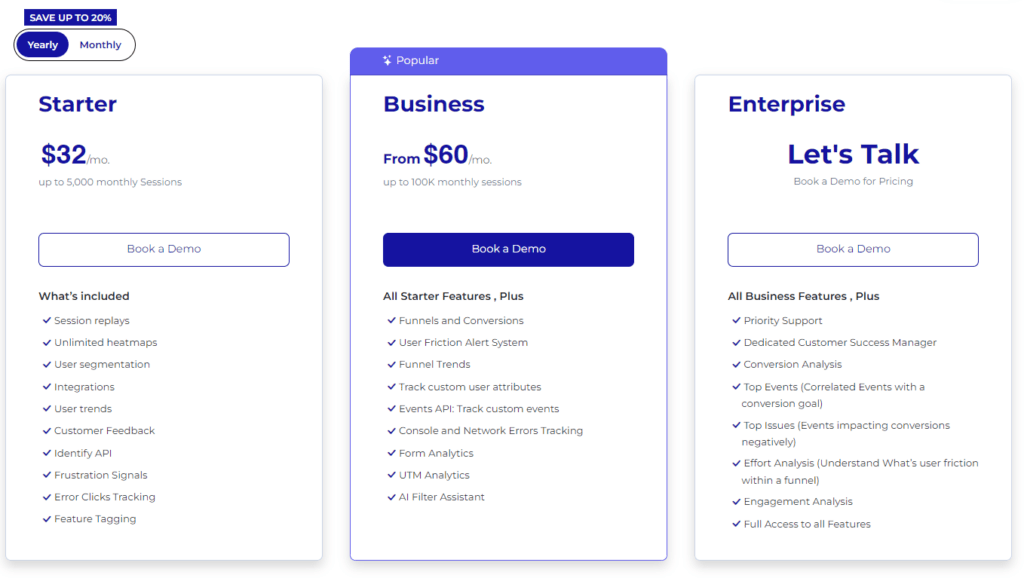
Here are more details on each plan.
- The Starter plan costs $39/month or $32/year and allows you to monitor up to 5,000 monthly sessions with up to 6 months of data storage.
- The Business plan costs $75/month or $60/year and helps you to track and analyze up to 100,000 monthly sessions with up to 12 months of data storage.
- The Enterprise plan has custom pricing and offers customizable sessions plus full access to all features.
Install Your First Product Analytics Tools Right Now
It takes less than 5 minutes to set up your first product analytics tools, with FullSession, and it's completely free!
FAQs About Product Analytics Tools
What features are must-haves in a product analytics tool?
First, you need to spot the trends, such as what sections of your site resonate with them and what sends them running. That means finding tools that offer event tracking, journey mapping, and up-to-the-minute updates that keep you in the loop.
Can I use these tools on mobile apps too?
Absolutely. Most product analytics tools like FullSession are built to handle data from both websites and mobile apps, so you can keep an eye on all the ways users interact with your product.
What’s the difference between product analytics and other types of analytics?
Product analytics specifically zeros in on how users engage with your product, while other analytics might focus more on broader business metrics or marketing performance. It’s like having a specialist for understanding user interaction.
Is there a free product analytics tool?
If you don't want to invest in a premium product analytics tool yet, start with Google Analytics. While this free resource can provide a solid foundation, it's not a silver bullet. Expect to supplementation with more in-depth data to really drive results.